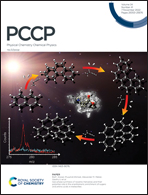Molecular dynamics simulations and solid-state nuclear magnetic resonance spectroscopy measurements of C–H bond order parameters and effective correlation times in a POPC-GM3 bilayer†
Abstract
Glycolipids such as gangliosides affect the properties of lipid membranes and in extension the interactions between membranes and other biomolecules like proteins. To better understand how the properties of individual lipid molecules can contribute to shape the functional aspects of a membrane, the spatial restriction and dynamics of C–H bond segments can be measured using nuclear magnetic resonance (NMR) spectroscopy. We combine solid-state NMR spectroscopy with all-atom molecular dynamics (MD) simulations to investigate how ganglioside GM3 affects the bilayer structure and dynamics of C–H bond segments. These two methods yield reorientational correlation functions, molecular profiles of C–H bond order parameters |SCH| and effective correlation times τe, which we compare for lipids in POPC bilayers with and without 30 mol% GM3. Our results revealed that all C–H segments of POPC reorient slower in the presence of GM3 and that the defining features of the GM3-POPC bilayer lie in the GM3 headgroup; it gives the bilayer an extended headgroup layer with high order (|SCH| up to 0.3–0.4) and slow dynamics (τe up to 100 ns), a character that may be mechanistically important in ganglioside interactions with other biomolecules.



 Please wait while we load your content...
Please wait while we load your content...